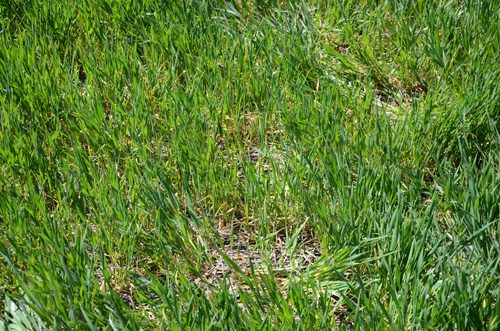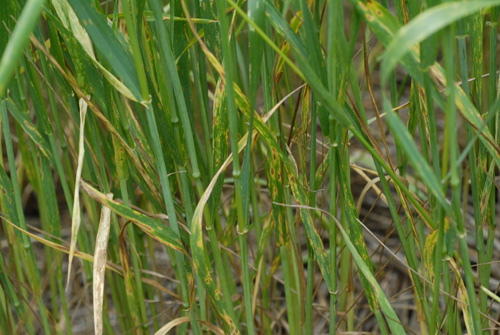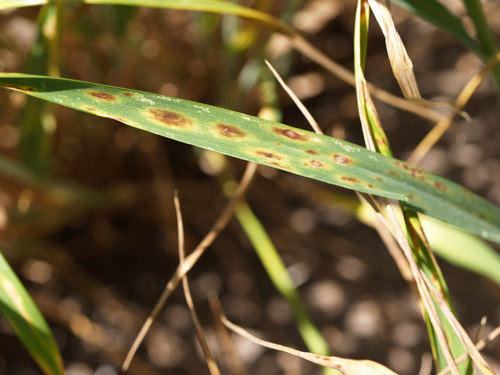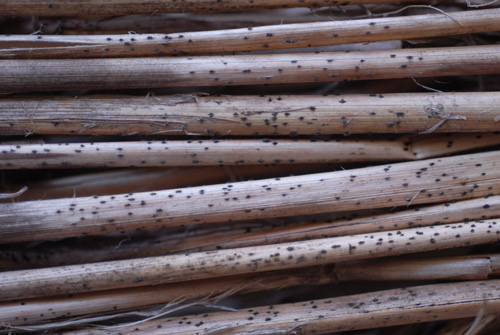G429
Tan Spot of Wheat
Tan spot is a major disease of winter wheat. This publication discusses the symptoms, development, and management of tan spot as well as crop residue management.
Stephen N. Wegulo, Extension Plant Pathologist
Robert N. Klein, Extension Western Nebraska Crops Specialist
Robert M. Harveson, Extension Plant Pathologist
Tan spot, caused by the fungus Pyrenophora tritici-repentis, is a major leaf spot disease of winter wheat in the Great Plains of North America. It is more severe in wheat cropping systems that maintain crop residue on the soil surface (Figure 1). Although tan spot can be a serious threat by itself, it occurs more often as part of a leaf spot complex involving tan spot, Septoria leaf blotch, and spot blotch. In Nebraska, tan spot symptoms usually appear in April, but its effect on yield loss is greatest during grain fill when severe spotting reduces the photosynthetic area of the upper leaves (Figure 2). The most severe damage occurs from the boot stage to the dough stage and is greatest on late tillers.
 |
| Figure 1. Wheat drilled into wheat residue on the soil surface. There is a high risk for the development of severe tan spot in this type of cropping system. |
 |
| Figure 2. Severe spotting reduces photosynthetic area on the upper leaves. |
Susceptible hosts of P. tritici-repentis include all classes of wheat, brome grass (Bromus spp.), wheat grass (Agropyron spp.), rye, and several native prairie grasses that may serve as sources of inoculum as well as sources of genetic diversity for the pathogen.
Symptoms
Tan spot first appears on wheat leaves as small, tan to brown lens- or diamond-shaped spots. Characteristic symptoms are elliptical to elongate spots that are tan colored, have a dark brown spot near the center, and are surrounded by a yellow border (Figure 3). The pattern of a small dark spot in a tan spot lesion along with the yellow border gives a distinctive “eye-spot” appearance. As the lesions increase in size, they tend to coalesce, producing larger, irregular areas of dead tissue. The lower, more mature leaves are infected first and the pathogen spreads to the upper leaves as the disease progresses. When leaves are young and actively growing, the spots typically remain small. Where spots are abundant, leaves may yellow, giving the field an overall yellow cast (Figure 4), which can be confused with nitrogen deficiency. Yellowing due to tan spot is intense, affects mostly the lower, older leaves, and tends to be localized to areas surrounding tan spot lesions. Yellowing due to nitrogen deficiency is more diffuse and uniformly affects all leaves on a plant. Under conditions that favor disease development and abundant sporulation (prolonged wet weather), seed infection may occur, resulting in a kernel symptom known as red smudge. This seedborne phase of the disease is usually not important epidemiologically.
 |
| Figure 3. Characteristic symptoms of tan spot. |
 |
| Figure 4. A wheat field with a yellow cast due to tan spot. The closeup picture in Figure 1 was taken in this field. |
As plants mature, the fungus invades the straw, where it produces tiny, black, raised, fruiting structures called pseudothecia (Figure 5). By mid-August, pseudothecia are visible on the stubble that remains after harvest and are diagnostic of tan spot. They feel like coarse sandpaper to the touch. The occurrence of pseudothecia on wheat stubble will confirm that at least part of the leaf damage observed on the crop was due to tan spot, even if leaf symptoms were not readily recognized.
 |
| Figure 5. Wheat stubble showing the raised pseudothecia of P. tritici-repentis. |
Disease Cycle and Epidemiology
Tan spot persistently occurs in many areas of Nebraska because of a monoculture (wheat-fallow-wheat or continuous wheat) of winter wheat coupled with the practice of leaving wheat residue standing to reduce erosion and conserve soil moisture. The tan spot fungus can survive and reproduce in bales of infested straw, on standing wheat stubble, or even on wheat stubble and straw that is on the soil surface or partially buried.
The disease cycle of tan spot is shown in Figure 6. Frequent rain during the growing season promotes wheat growth as well as disease development. Spores, called ascospores, are produced in pseudothecia and spread by wind or blowing rain. They are the primary source of infection of the lower, more mature leaves during tillering and early jointing. After the initial infection, the fungus spreads within a field or to neighboring fields by a different type of spore called a conidium (plural: conidia). This spore is produced in the tan spot lesions. Conidia are spread by wind or blowing rain and infect the upper leaves in the same field or in neighboring fields.
 |
| Figure 6. Schematic diagram of the disease cycle of tan spot. |
The disease progresses most rapidly during rainy, misty, or foggy weather. New releases of spores occur with each wet period. Free moisture on the leaf surface is the most critical environmental factor associated with infection. A 6- to 48-hour wet period is required for infection to occur. The duration of the wet period required for infection depends on the prevailing temperature. It is shorter during warm conditions and longer in cold weather. Symptoms appear within five to seven days after infection.
Economic Importance
Tan spot has the potential to significantly reduce yield and hence profitability for wheat farmers. Yield losses of up to 50 percent have been documented. Where continuous wheat culture is practiced, susceptible cultivars are grown, and minimum or no tillage is practiced, tan spot is one of the major constraints in commercial wheat production.
Management
A unique three-year conservation tillage rotation system called ecofarming (ecofallow) can be used to reduce the damage caused by tan spot. Ecofarming is defined as a crop rotation system that controls weeds and conserves soil moisture with minimum disturbance of crop residue. In this system, corn or sorghum is seeded directly into winter wheat stubble in a winter wheat-grain sorghum or corn-fallow rotation. In the ecofarming system, a crop is planted directly into the residue of a different crop, rather than into the residue of the same crop. This crop rotation-fallow system effectively breaks disease cycles that involve host-specific pathogens — such as tan spot — that survive in crop residue.
Another strategy for managing tan spot is planting resistant cultivars. Wheat cultivars with varying levels of resistance to the disease are available. Adaptation to local growing conditions should be considered when choosing cultivars based on resistance to tan spot.
Fungicide application can be used to manage tan spot when susceptible or partially resistant cultivars are grown and environmental conditions favor disease development. The first step in deciding to use a fungicide is to determine disease progress and estimate yield potential. Crop scouting should begin around the early jointing stage and continue on a regular basis until disease is detected or a decision to spray is made based on the observed disease level, yield potential, and the price of wheat. For an illustration of the potential net profit from foliar fungicide treatment of wheat, see NebGuide G1979, Foliar Diseases of Winter Wheat: Management with Fungicides.
The fungicides listed in Table I are registered for control of foliar diseases of wheat. There are restrictions specific to each fungicide regarding intervals between applications, the number of times the fungicide can be applied per growing season, the amount of fungicide that can be applied per acre or during a growing season, the pre-harvest interval, or feeding of grain or hay to livestock. Always read and follow label directions.
| Table I. Fungicides registered for use on wheat to control foliar diseases1. | |||||
| Fungicide trade name2 | Active ingredient | Fungicide class | Rate (per acre) | Re-entry interval (REI) (hours) |
Pre-harvest interval (PHI) (days) |
| Absolute® |
tebuconazole + trifloxystrobin | triazole + strobilurin | 5.0 fl oz |
24 |
35 |
| Alto® | cyproconazole | triazole | 3.0-5.5 fl oz |
12 |
30 |
| Bumper® | propiconazole | triazole | 4.0 fl oz |
24 |
40 |
| Caramba™ | metconazole | triazole | 10.0-14.0 fl oz |
12 |
30 |
| Evito® | fluoxastrobin | strobilurin | 2.0-4.0 fl oz |
12 |
Apply no later than Feekes 10.5 (full heading) |
| Folicur® | tebuconazole | triazole | 4.0 fl oz |
12 |
30 |
| Headline® | pyraclostrobin | strobilurin | 6.0 fl oz |
12 |
Apply no later than Feekes 10.5 |
| ManKocide® | Mancozeb + copper hydroxide | Dithiocarbamate + inorganic | 1.7 lb |
48 |
Apply no later than Feekes 10.5 |
| Muscle™ | tebuconazole | triazole | 4.0 fl oz |
12 |
30 |
| Orius® | tebuconazole | triazole | 4.0 fl oz |
12 |
30 |
| Priaxor™ | fluxapyroxad + pyraclostrobin | carboxamide + strobilurin | 8.0 fl oz |
12 |
Apply no later than Feekes 10.5 |
| Proline® | prothioconazole | triazole | 4.3-5.7 fl oz |
12 |
30 |
| PropiMax® | propiconazole | triazole | 2.0-4.0 fl oz |
24 |
40 |
| Prosaro® | prothioconazole + tebuconazole | triazole + triazole | 6.5-8.2 fl oz |
12 |
30 |
| Quadris® | azoxystrobin | strobilurin | 6.0-15.5 fl oz |
4 |
Apply no later than Feekes 10.5 |
| Quilt® | propiconazole + azoxystrobin | triazole + strobilurin | 10.5-14.0 fl oz |
12 |
Apply no later than Feekes 10.5 |
| Quilt® Xcel | azoxystrobin + propiconazole | strobilurin + triazole | 10.5-14.0 fl oz |
12 |
Apply no later than Feekes 10.5 |
| Stratego® | propiconazole + trifloxystrobin | triazole + strobilurin | 10.0 fl oz |
12 |
Apply no later than Feekes 10.5 |
| Stratego® YLD | prothioconazole + trifloxystrobin | triazole + strobilurin | 4.0 fl oz |
12 |
Apply no later than Feekes 10.5 |
| Tebuzol™ | tebuconazole | triazole | 4.0 fl oz |
12 |
30 |
| Tilt® | propiconazole | triazole | 2.0-4.0 fl oz |
12 |
30 |
| Toledo® | tebuconazole | triazole | 4.0 fl oz |
12 |
30 |
| TwinLine™ | pyraclostrobin + metconazole | strobilurin + triazole | 7.0-9.0 fl oz |
12 |
Apply no later than Feekes 10.5 |
| Vertisan™ | penthiopyrad | carboxamide | 10.0-24.0 fl oz |
12 |
Apply no later than Feekes 10.5.1 (flowering) |
| 1This list is presented for information only and no endorsement is intended for products listed or criticism meant for products not listed. Consult the product label before buying and using a specific fungicide. Read and follow all label directions and restrictions. 2The label on most of the products listed in Table I recommends adding an appropriate adjuvant such as a spreader sticker and applying in sufficient water to ensure good coverage. Higher carrier rates usually improve control. It is very important to select application equipment that gives the spray particle size suggested on the label. |
|||||
This publication has been peer reviewed.
Disclaimer Reference to commercial products or trade names is made with the understanding that no discrimination is intended of those not mentioned and no endorsement by University of Nebraska–Lincoln Extension is implied for those mentioned. |
Visit the University of Nebraska–Lincoln Extension Publications website for more publications.
Index: Plant Diseases
Wheat
1979, 1993, 2006, Revised December 2012